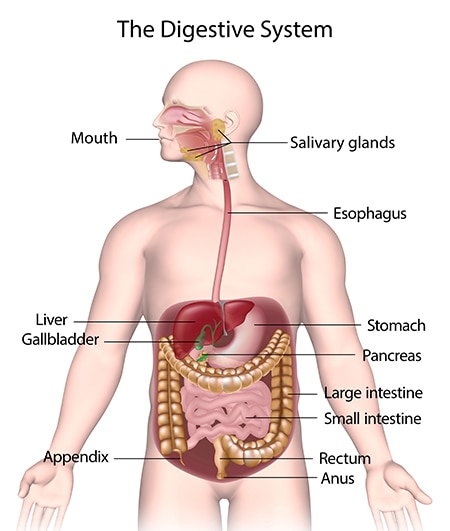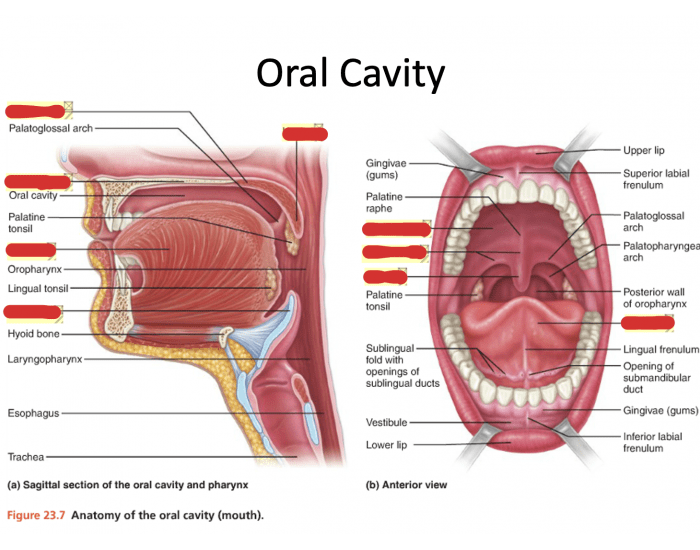Answer Unlock Previous question Next question Transcribed image text: work Correctly label the following anatomical features of the oral cavity. Sublingual ortice Upper io Palaopharyngeal Palatino tone Lower lip Lingual trenulum Superofimia! Tongue inferior labial i Il frenulum Submandibular orifice Reset Zoom < Prev 23 of 50 ! Next >
Solved orrectly label the following anatomical features of | Chegg.com
The oral cavity, better known as the mouth, is the start of the alimentary canal. It has three major functions: Digestion – receives food, preparing it for digestion in the stomach and small intestine. Communication – modifies the sound produced in the larynx to create a range of sounds. Breathing – acts as an air inlet in addition to the

Source Image: healthline.com
Download Image
The cheeks, tongue, and palate frame the mouth, which is also called the oral cavity (or buccal cavity). The structures of the mouth are illustrated in Figure 23.7. At the entrance to the mouth are the lips, or labia (singular = labium). Their outer covering is skin, which transitions to a mucous membrane in the mouth proper.

Source Image: quizlet.com
Download Image
The Human Alimentary canal: Grade 9 Understanding for IGCSE Biology 2.27 | PMG Biology The alveolar bone is covered by specialized oral mucosa known as gingiva, or, more commonly, gums. The remainder of the oral cavity is covered with an oral mucous membrane. Tooth germ formation of the primary or baby teeth begins 7 to 10 weeks in utero. This is followed by enamel and dentin apposition from 4 to 6 weeks in utero.

Source Image: niddk.nih.gov
Download Image
Correctly Label The Following Anatomical Features Of The Oral Cavity
The alveolar bone is covered by specialized oral mucosa known as gingiva, or, more commonly, gums. The remainder of the oral cavity is covered with an oral mucous membrane. Tooth germ formation of the primary or baby teeth begins 7 to 10 weeks in utero. This is followed by enamel and dentin apposition from 4 to 6 weeks in utero. Oral Cavity. Above: Anatomy of the oral cavity. The oral cavity is the entry point into the digestive system. It is equipped with teeth and a tongue to grind up and break apart foodstuffs to begin physical digestion. Chemical digestion also begins in the mouth with enzymes produced and secreted by three pairs (right and left) of salivary glands
Your Digestive System & How it Works – NIDDK
Nov 3, 2023The cavity is separated into anterior and posterior parts by the dental arches (or teeth): the anterior oral vestibule sits anteriorly to the teeth and behind the lips, whilst the oral cavity proper describes the area behind the teeth. Label oral cavity Quiz

Source Image: purposegames.com
Download Image
Premium Vector | Teeth oral cavity illustration of the oral cavity with teeth that are numbered Nov 3, 2023The cavity is separated into anterior and posterior parts by the dental arches (or teeth): the anterior oral vestibule sits anteriorly to the teeth and behind the lips, whilst the oral cavity proper describes the area behind the teeth.

Source Image: freepik.com
Download Image
Solved orrectly label the following anatomical features of | Chegg.com Answer Unlock Previous question Next question Transcribed image text: work Correctly label the following anatomical features of the oral cavity. Sublingual ortice Upper io Palaopharyngeal Palatino tone Lower lip Lingual trenulum Superofimia! Tongue inferior labial i Il frenulum Submandibular orifice Reset Zoom < Prev 23 of 50 ! Next >

Source Image: chegg.com
Download Image
The Human Alimentary canal: Grade 9 Understanding for IGCSE Biology 2.27 | PMG Biology The cheeks, tongue, and palate frame the mouth, which is also called the oral cavity (or buccal cavity). The structures of the mouth are illustrated in Figure 23.7. At the entrance to the mouth are the lips, or labia (singular = labium). Their outer covering is skin, which transitions to a mucous membrane in the mouth proper.

Source Image: pmgbiology.com
Download Image
A&P Content Flashcards | Quizlet Aug 14, 2023Introduction The oral cavity, or more commonly known as the mouth or buccal cavity, serves as the first portion of the digestive system. It consists of several different anatomically different aspects that work together effectively and efficiently to perform several functions. These aspects include the lips, tongue, palate, and teeth.

Source Image: quizlet.com
Download Image
Physiology of pregnancy and oral local anesthesia considerations [PeerJ] The alveolar bone is covered by specialized oral mucosa known as gingiva, or, more commonly, gums. The remainder of the oral cavity is covered with an oral mucous membrane. Tooth germ formation of the primary or baby teeth begins 7 to 10 weeks in utero. This is followed by enamel and dentin apposition from 4 to 6 weeks in utero.
![Physiology of pregnancy and oral local anesthesia considerations [PeerJ]](https://dfzljdn9uc3pi.cloudfront.net/2023/15585/1/fig-1-full.png)
Source Image: peerj.com
Download Image
Premium PSD | Tooth anatomy cheek tooth dental infographics Oral Cavity. Above: Anatomy of the oral cavity. The oral cavity is the entry point into the digestive system. It is equipped with teeth and a tongue to grind up and break apart foodstuffs to begin physical digestion. Chemical digestion also begins in the mouth with enzymes produced and secreted by three pairs (right and left) of salivary glands

Source Image: freepik.com
Download Image
Premium Vector | Teeth oral cavity illustration of the oral cavity with teeth that are numbered
Premium PSD | Tooth anatomy cheek tooth dental infographics The oral cavity, better known as the mouth, is the start of the alimentary canal. It has three major functions: Digestion – receives food, preparing it for digestion in the stomach and small intestine. Communication – modifies the sound produced in the larynx to create a range of sounds. Breathing – acts as an air inlet in addition to the
The Human Alimentary canal: Grade 9 Understanding for IGCSE Biology 2.27 | PMG Biology Physiology of pregnancy and oral local anesthesia considerations [PeerJ] Aug 14, 2023Introduction The oral cavity, or more commonly known as the mouth or buccal cavity, serves as the first portion of the digestive system. It consists of several different anatomically different aspects that work together effectively and efficiently to perform several functions. These aspects include the lips, tongue, palate, and teeth.